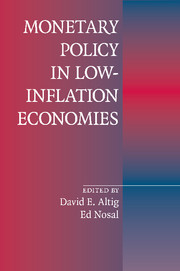Book contents
- Frontmatter
- Contents
- Contributors
- Acknowledgments
- Introduction
- 1 The Welfare Cost of Inflation in the Presence of Inside Money
- Commentary
- 2 An Open-Economy Model of Endogenous Price Flexibility
- Commentary
- 3 Efficient Inflation Targets for Distorted Dynamic Economies
- Commentary
- 4 Inflation and Welfare in Models with Trading Frictions
- Commentary
- 5 Good versus Bad Deflation: Lessons from the Gold Standard Era
- Commentary
- 6 Monetary Policy Orientation in Times of Low Inflation
- Commentary
- 7 Observations on Disinflation in Transition Economies
- Commentary
- 8 Inflation and Financial Market Performance: What Have We Learned in the Last Ten Years?
- Commentary
- Index
Commentary
Published online by Cambridge University Press: 26 January 2010
- Frontmatter
- Contents
- Contributors
- Acknowledgments
- Introduction
- 1 The Welfare Cost of Inflation in the Presence of Inside Money
- Commentary
- 2 An Open-Economy Model of Endogenous Price Flexibility
- Commentary
- 3 Efficient Inflation Targets for Distorted Dynamic Economies
- Commentary
- 4 Inflation and Welfare in Models with Trading Frictions
- Commentary
- 5 Good versus Bad Deflation: Lessons from the Gold Standard Era
- Commentary
- 6 Monetary Policy Orientation in Times of Low Inflation
- Commentary
- 7 Observations on Disinflation in Transition Economies
- Commentary
- 8 Inflation and Financial Market Performance: What Have We Learned in the Last Ten Years?
- Commentary
- Index
Summary
I'm delighted to be here, but I have both good news and bad news to report. The good news is that I have the opportunity to comment on a terrific paper. Michael Devereux has done his usual superb job of characterizing an important issue in a transparent and elegant way. The bad news is that his paper involves monetary economics and exchange rates, two topics I've successfully avoided for most of my life. The papers at this conference remind us that monetary economics involves not only practical questions of policy but also deep philosophical questions about the value of colored pieces of paper and why anyone would exchange something of value for paper, or even the promise of future paper or a bank liability exchangeable for paper. Devereux's model has two kinds of paper and revolves around the price at which one is exchanged for the other. I'm lost already, and maybe you are, too.
The question that Devereux addresses is how the exchange rate (the relative price of two kinds paper) affects the allocation of resources. Is the allocation better if the exchange rate is fixed or if we allow it to vary in response to various shocks that hit the economy? It's a classic question, but we are a long way from a definitive answer. It's relatively easy to write down models in which the exchange rate is irrelevant.
- Type
- Chapter
- Information
- Monetary Policy in Low-Inflation Economies , pp. 52 - 60Publisher: Cambridge University PressPrint publication year: 2009



